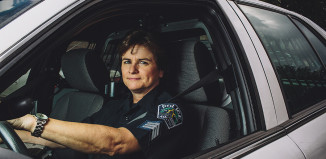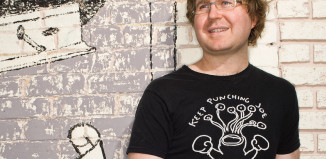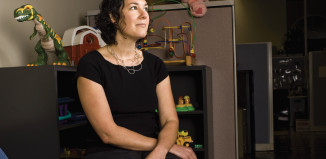Geo Sanchez and his partner Aaron Johnson adopted their dog Sai three years ago. As Sanchez tells it, the boxer “seduced him” at a weekend adoption day, and they quickly connected with Austin Boxer Rescue to take him in. now the couple has three other dogs: another rescued boxer named Hiro and two Chihuahuas, Tobi and Mina. Life is pretty sweet for these pups that go on four or five walks a day, get plenty of toys, and are admittedly, according to Sanchez, “spoiled rotten.”
“They’re kind of like our kids,” he said, acknowledging the birthday parties complete with special doggie treats and the regular trips to the dog park. “We do whatever we need to do to make sure they’re happy and well taken care of.”
Sanchez and Johnson are far from alone. Research shows that gays and lesbians are big pet owners, and many spend a good deal on their furry family members.
That’s contributed to a booming pet industry, which continues to be in growth mode despite the sluggish economy. Spending rose to more than $47 billion in 2010, up from $45 billion in 2009, the American Pet Products Association reports. And in the last three years, pet-related spending has steadily increased at least $2 billion annually.
“Pet spending is not perceived as an extravagance,” said David Paisley, senior projects manager with San Francisco-based community Marketing Inc., which specializes in gay and lesbian market research. “People are cutting back on a new suit or a new car, but they’re not cutting back on their pets, in part because this type of spending comes in little chunks and not all at once. Also, during a recession, things that create an emotional bond, like pets, are big.”
Interestingly, Texans appear to be setting the pace for pet ownership. According to Community Marketing’s 2010 Gay & Lesbian Consumer Index, gay and lesbian dog ownership is considerably higher in Texas than the country as a whole, while cat ownership is about the same. The research shows that 31 percent of Texas gay men have a dog compared with 24 percent nationwide. It also shows that 43 percent of lesbians in the Lone Star State care for a dog, compared with a U.S. average of 37 percent. as for cats, 16 percent of gay men and 35 percent of lesbians care for a feline in Texas and across the country. The takeaway: Texas is dog country.
Paisley said that while more gays and lesbians are having children today, most still don’t have kids living at home. “What gay and lesbian singles and couples do have is a high likelihood of pet ownership,” he added. “And we are spending a lot on our pets.”
Take cats, for instance. Community Marketing’s data shows that U.S. lesbians who live with cats spend a median of $100 a month on their cats, while gay men estimate their cat-related expenditures at around $65 a month. It’s a significant chunk of change.
Now, corporate America is starting to take notice of an untapped marketing strategy. For years, those in the pet industry, from dog day care centers to pet supply stores, have been marketing to gay consumers via targeted media platforms, mostly on the local level. But these days, national companies of all stripes interested in attracting the gay dollar are starting to use the pet effect to their advantage, said Paisley.
“Traditionally, those trying to connect with the gay market have used the gay couple in the ad, but now we’re getting immune to that image,” he said. “So now what we’re seeing is a lot of companies trying to stand out, and they’re using pets, because pets cause emotion.”
One example is the Kimpton Hotel & Restaurant Group, a company known for its animal-friendly policies and that has also long courted gay consumers. Kimpton has dedicated part of its website to marketing directly to LGBT consumers. The images shown on the site depict gay and lesbian couples with their pets.
One person who has a handle on the pet industry and the relative effect of the gay community is Liz Parker, the publisher of Austin Pets Directory, a monthly magazine for pet-loving locals. Parker said the magazine “has a huge gay and lesbian readership.” What’s more, she added, her advertisers report significant gay and lesbian clientele, as do the local animal nonprofits she works with.
Parker said while she agrees that gay and lesbian consumers may often have more expendable income than the average consumer, that’s not the only reason we see a higher propensity to spend on pets. “I believe their spending patterns probably have a lot to do with values and priorities,” she said. “In my experience, gay and lesbian owners consider their pets to be more like family members and less like owned property.”
Marie Cloutier, with Austin Boxer Rescue, sees a similar reality. Cloutier, who worked with Sanchez and Johnson when they adopted their dogs, says that the gay men and lesbians she encounters through the organization often have a heightened sense of responsibility and compassion for the animals they adopt. “We get excited when we see an application from a gay or lesbian family,” she said. “Our animals have sometimes been through a lot, and they need people who are going to be compassionate and understanding and not give up on the animal. The reality is that, while we have great adopters across the board, those in the gay community tend to be more willing to take part in the process.”
Sanchez said he doesn’t think his and Johnson’s attitude toward their pets is at all unusual. He says many of their gay friends view their own pets as their number one priority. “It’s something that’s pretty common, at least among the people we hang out with.”
Perhaps some of that is augmented by the mindset that comes with living in Austin, which Parker said is a unique market for pet pampering purchases. “Austinites seem to spend money based on perceived quality more than frivolity,” she said. “This is the market that doesn’t mind paying a premium for natural and organic food, treats and pet hygiene products. People in Austin are active and healthy, and so are their pets. I think the way we spend money on our pets reflects that.”



































